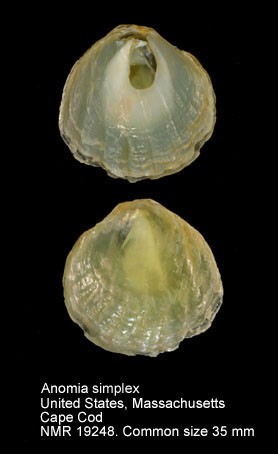Invasion History
First Non-native North American Tidal Record:First Non-native West Coast Tidal Record:
First Non-native East/Gulf Coast Tidal Record:
General Invasion History:
Anomia simplex is native to the Northwest Atlantic from Cape Cod to Brazil. It is found in shallow coastal waters and in upper mesohaline to euhaline salinities. It settles on hard substrates, and is frequently associated with oysters (Wass 1972; Morris 1975; Gosner 1978).
North American Invasion History:
Invasion History on the West Coast:
Anomia simplex is known from the West Coast only from 'three worn valves' dredged on Atlantic oyster beds in South San Francisco Bay (in 1912, Packard 1918, cited by Carlton 1979). Live animals or dead shells of this bivalve were probably introduced with oysters planted in San Francisco Bay, from Long Island Sound, in the late 1800s (Carlton 1979; Miller 2000). There is no evidence that a breeding population existed in San Francisco Bay.
Description
Anomia simplex is a marine bivalve with a thin, translucent shell, often called a 'potato chip shell'. The lower (right) valve is flat and permanently attached to a hard substrate by a stalk-like byssus, which passes through a hole in the shell near the hinge (Morris 1975; Gosner 1978, Yamaguchi 1998). The upper (left) valve is dome-like. The shell is roughly circular, but the margins can be undulating or jagged. The usual size range is 25-50 mm, but can occasionally reach 75 mm. The color varies from sulfur yellow to copper red, and sometimes silvery, grey, or black. The shell attaches to rocks, shells, wood, or man-made structures (Morris 1975; Gosner 1978).
Taxonomy
Taxonomic Tree
| Kingdom: | Animalia | |
| Phylum: | Mollusca | |
| Class: | Bivalvia | |
| Subclass: | Pteriomorphia | |
| Order: | Ostreoida | |
| Family: | Anomiidae | |
| Genus: | Anomia | |
| Species: | simplex |
Synonyms
Potentially Misidentified Species
Ecology
General:
Adults of Anomia simplex are firmly attached to hard substrates, such as rocks, shells, wood, and man-made structures (Morris 1975; Gosner 1978; Yamaguchi 1998). These bivalves are suspension feeders and their larvae are planktotrophic (Chanley and Andrews 1971). After settlement, postlarvae are mobile for a time, and then attach to a surface by a calcified byssus. Up to a size of 10 mm, they can detach from a surface, and reattach. As they develop further, their ability to change their position or orientation decreases (Yamaguchi 1998).
Food:
Phytoplankton
Trophic Status:
Suspension Feeder
SusFedHabitats
| General Habitat | Rocky | None |
| General Habitat | Coarse Woody Debris | None |
| General Habitat | Marinas & Docks | None |
| Salinity Range | Polyhaline | 18-30 PSU |
| Salinity Range | Euhaline | 30-40 PSU |
| Tidal Range | Subtidal | None |
| Tidal Range | Low Intertidal | None |
| Vertical Habitat | Epibenthic | None |
Tolerances and Life History Parameters
| Minimum Salinity (‰) | 12.5 | Experimental (Castagna and Chanley 1973) |
| Minimum Length (mm) | 25 | Morris 1975; Gosner 1978 |
| Maximum Length (mm) | 75 | Morris 1975; Gosner 1978 |
| Broad Temperature Range | None | Cold temperate-Warm temperate |
| Broad Salinity Range | None | Polyhaline-Euhaline |
General Impacts
Anomia simplex is known as an introduced species only from three dead shells on the West Coast, and has had no known impacts outside its native range.Regional Distribution Map
Non-native
Native
Cryptogenic
Failed
Occurrence Map
References
Abbott, R. Tucker (1974) American Seashells, Van Nostrand Reinhold, New York. Pp. <missing location>Carlton, James T. (1979) History, biogeography, and ecology of the introduced marine and estuarine invertebrates of the Pacific Coast of North America., Ph.D. dissertation, University of California, Davis. Pp. 1-904
Castagna, M.; Chanley, P. (1973) Salinity tolerance of some marine bivalves from inshore and estuarine environments in Virginia waters on the western mid-Atlantic coast., Malacologia 12(1): 47-96
Chanley, Paul; Andrews, J. D. (1971) Aids for identification of bivalve larvae of Virginia, Malacologia 11(1): 45-119
Gosner, Kenneth L. (1978) A field guide to the Atlantic seashore., In: (Eds.) . , Boston. Pp. <missing location>
Miller, Alexander Whitman (2000) <missing title>, University of California at Los Angeles, Los Angeles. Pp. <missing location>
Morris, Percy A. (1975) A field guide to shells of the Atlantic, Houghton-Mifflin, Boston. Pp. <missing location>
Rosenberg, Gary 1995-2023 Malacolog 4.1. http://www.malacolog.org/
Wass, Melvin L. (1972) A checklist of the biota of lower Chesapeake Bay, Special Scientific Report, Virginia Institute of Marine Science 65: 1-290
Yamaguchi, K. (1998) Cementation vs mobility: development of a cemented byssus and flexible mobility in Anomia chinensis, Marine Biology 132: 651-661
